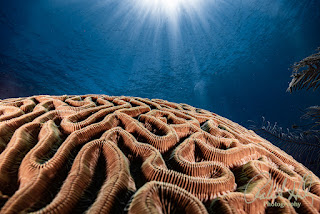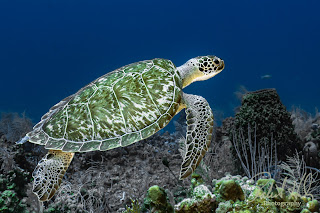Removing Backscatter in Lightroom: Techniques for Cleaner Shots
As an underwater photographer, there's nothing more frustrating than capturing the perfect shot—you're happy with your composition, the marine life is beautifully framed, and the colors look vibrant. Then you notice unwanted white dots scattered across your image. These are backscatter, and they happen when tiny particles suspended in the water reflect your camera's light source, creating those distracting spots that can ruin an otherwise stunning photo.
Whether you're using a professional DSLR with a strobe or a compact camera inside an affordable housing, backscatter can be a persistent challenge. It's a common issue faced by many underwater photographers. Still, the good news is that Lightroom Classic (v14.5), Lightroom (cloud-based) v8.5, Lightroom Mobile (v9.5), and Adobe Camera Raw (v17.5) now include powerful AI-assisted and manual tools designed to help you remove backscatter quickly and accurately, on desktop or mobile.
Recent updates bring faster Select Background and Select Object performance, improved Select People for diver portraits (even through bubbles or masks), and Luminance Range Masking to Lightroom Mobile for the first time. These improvements make it easier than ever to restore clarity, whether you're editing a single macro shot or a week's worth of wide-angle reefscapes.
In the following sections, we'll walk through a five-method toolkit, step-by-step, so you can confidently tackle backscatter with the most current tools available.
🔗 Learn more at: info.robertherb.com/lm-2-blog
🌊 Method 1: Spot Removal Tool - For Precise Manual Cleanup
Best For: Sparse backscatter on solid backgrounds (blue water, coral walls, macro sand)
Steps:
-
Press Q to activate the Spot Removal Tool.
-
Zoom to 1:1 (or 2:1 for tiny specs) with Z.
-
Choose Heal or Clone mode (Heal now blends more smoothly in v14.5).
-
Adjust brush size with [ and ], then click on each backscatter spot.
-
Use H to toggle visibility of the overlay pins if needed.
📸 Why It Works: This method gives you complete manual control. The improved healing algorithm produces cleaner edges around high-contrast details like dive masks or strobe arms, making it my go-to for macro nudibranch shots or bluewater backgrounds with minimal movement.
🧠 Method 2: AI Object Selection + Invert Mask - Target Background Only
Best For: Isolating a subject (diver, turtle, seahorse) and targeting backscatter behind it.
Steps:
-
Press Shift + W to enter the Masking Panel.
-
Use Select Background (new in v14.5) for one-click isolation, or Select Object / Select Subject for finer control.
-
Invert if needed to switch from subject to background.
-
Reduce Texture (-30 to -50) and Clarity (-10 to -20) to soften particle visibility.
📸 Why It Works: The new background detection is more accurate at separating divers from water, even with gear or bubbles in frame. Ideal for portraits where particle clutter competes with the subject.
🌗 Method 3: Luminance Range Masking — Remove Bright Backscatter
Best For: Backscatter in sunbeams or evenly lit bluewater.
Steps:
-
Press Shift + W to open Masking.
-
Select Luminance Range and click the bright area of the water.
-
Narrow the range to target white specs only (around 70–100).
-
Reduce Whites (-15), Contrast (-10), and Sharpness (-20) to mute the dots.
📸 Why It Works: Now in Lightroom Mobile v9.5, luminance masking lets you run this same background particle cleanup on the boat between dives. No more waiting until you're back at a desktop.
🔄 Method 4: Combine AI Masking + Spot Removal for Batch Cleanup
Best For: Dive series with repetitive backgrounds or consistent lighting.
Steps:
-
Mask the Background or Invert Subject.
-
Apply clarity/texture reduction to minimize particle contrast.
-
Use Spot Removal for distracting specks.
-
Save your adjustments as a Mask Preset (v14.5+) called "Backscatter Cleanup."
-
Apply this preset or Sync Settings (Ctrl+Shift+S) across similar shots.
📸 Why It Works: You can now save your exact mask setup for reuse across trips, which means consistent results without rebuilding masks every time.
✨ Method 5: Lightroom Mobile - On-the-Go Cleanup
Best For: Editing while traveling light.
Steps:
-
Open your shot in Lightroom Mobile (v9.5).
-
Tap the Healing Tool to remove obvious spots.
-
Use Masking > Select Background or Luminance Range to soften visible particles in bright water.
📸 Why It Works: Mobile now supports both background detection and luminance targeting, so you can run nearly the same cleanup workflow anywhere.
Example: Removing Backscatter from a Diver in Blue Water
🎯 Scenario: A wide-angle diver portrait with backscatter on both diver and water.
Step 1: Select the Diver
-
Shift + W > Select Subject, refined in v14.5 for better gear/bubble detection.
-
Name mask "Diver - Cleanup."
Step 2: Clean Diver with Spot Removal
-
Q, Heal mode, feather ~70, click on white specks.
-
Improved blending in v14.5 reduces haloing on high-contrast edges.
Step 3: Invert to Select Background
-
Texture -40, Clarity -15, optional Dehaze -5.
-
Maintains detail while lowering particle visibility.
Step 4: Luminance Range for Bright Specs
-
Target 70–100 luminance values.
-
Reduce Whites/Contrast/Sharpness.
Step 5: Save & Sync
-
Save as "Backscatter Cleanup" mask preset.
-
Sync to other shots for batch cleanup.
🧭 Manual vs AI: When to Use Each
| Situation | Manual (Spot Removal) | AI / Auto Tools |
|---|---|---|
| Macro shots on sand | ✅ | 🔸 Background softening only |
| Diver portraits | ✅ + Invert Mask combo | ✅ Background clarity adjustment |
| Bluewater ambient scenes | 🔸 Luminance Mask | ✅ Background AI cleanup |
| Large batch with similar lighting | 🔸 Time-intensive | ✅ Mask Preset + Batch Sync |
| Mobile usage | ✅ Quick clone | ✅ AI Mask + Luminance Mask |
📂 Compatible File Formats
-
RAW (DNG, NEF, ARW, CR3) - Best flexibility
-
JPEG - Fully supported
-
TIFF / PSD - After Photoshop round-trips
-
HEIC / HEIF - Supported in latest Lightroom builds
-
Compressed RAW formats like Canon C-RAW & Nikon HE* are now fully compatible with these masking and healing tools.
💡 Pro Tip: Always shoot and edit in RAW for maximum flexibility.
🌟 Final Thoughts: Embrace the Cleanup, Not the Clutter
Backscatter can be pretty frustrating, especially for those just starting out in underwater photography. It's a common issue that can make your beautiful underwater shots look speckled and less professional. However, it's important to remember that backscatter is far from unfixable. With the right tools and a bit of patience, you can significantly improve your images.
Thanks to the continuously evolving toolkit in Lightroom, addressing backscatter has become easier and more effective. Features like AI masking, range masking, and advanced healing tools allow you to target and remove tiny distractions quickly and precisely. These innovations give you more flexibility than ever before, making the editing process both accessible and rewarding.
As you surface from each dive and review your shots, don't be quick to dismiss images that appear speckled or imperfect. Instead, see them as opportunities for learning and improvement. With some targeted adjustments, such as applying spot healing or adjusting masking settings, you can transform those photos into stunning, portfolio-worthy images that truly capture the clarity, vibrant colors, and beauty of your underwater adventures.
Remember, every photographer encounters challenges, and persistence combined with these modern editing tools will help you create awe-inspiring underwater images that stand out. Keep experimenting, stay patient, and enjoy the journey of evolving your underwater photography skills.
- Bob Herb
📷 info.robertherb.com/lm-2-blog
🐠 Ready to Dive Deeper?
Follow my weekly blog at Robert Herb Photography Blog.
Share your results using #RobertHerbPhotography.
🧭 What's Next?
🟦 Have you tried any of these techniques yet? Share your edits using #RobertHerbPhotography.
🟦 Want to see these workflows in action? Sign up for my upcoming training course at RobertHerb.com or reach out at bob@robertherb.com
🟦 And don't forget—new blogs drop weekly at Robert Herb Photography Blog
Until next time… dive deep, shoot smart, and let Lightroom bring your vision to the surface.
Written by Robert Herb – Empowering underwater photographers to capture and enhance the beauty of our oceans since 1978
Stay tuned for more in-depth insights into underwater photography. Let's dive deeper into the art and craft of capturing the marine world! If you have any comments or suggestions, I'd love to hear them.
Get ready for an exciting underwater photography adventure! For more details on my upcoming online training course, check out my "Training" page at RobertHerb.com or email me at bob@robertherb.com.
Sincerely,
Bob Herb
|
|





Comments
Post a Comment
Please let me know your comments.